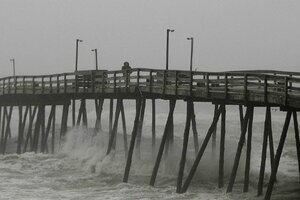Hurricane Irene update: Now Category 1 but major impact still ahead
Hurricane Irene has been downgraded to a Category 1 storm. But as it makes landfall in North Carolina and heads north, it's still expected to pack a wallop with the greatest danger from flooding due to heavy rainfall and coastal storm surges.

A man walks along Avalon Pier in Kill Devil Hills, Outer Banks, N.C. Saturday as Hurricane Irene reaches the North Carolina coast. Irene slammed into North Carolina's coast around dawn Saturday with howling winds and drenching rains amid reports of flooding and tens of thousands of people without power.
Charles Dharapak/AP
Hurricane Irene seemed to have lost some of its oomph as it approached the coast of North Carolina early Saturday morning, downgraded to a Category 1 storm with maximum sustained winds of 90 miles per hour.
Moving along at 14 miles toward the north-northeast, Irene was expected to make landfall near Atlantic Beach, North Carolina, between 8-10 a.m.
But the storm is not without fury, and it already has knocked out power for some 160,000 customers as it heads on its expected path toward the Mid-Atlantic States, New York, and New England.
Some trees were down along the hurricane’s path, taking down power lines, and officials warned that the greatest damage could come from flooding as rainfall of up to 10 inches is predicted in some areas. Storm surges of up to 11 feet have been forecast as well.
In North Carolina, evacuations have been underway in 18 counties, and Gov. Bev Perdue has declared a state of emergency for all counties east of Interstate 95.
As the storm proceeded on its path northward, President Obama declared a state of emergency in Virginia on Saturday, providing federal aid to help state and local agencies deal with the aftermath of the storm.
“Irene is expected to remain near the threshold of category one and category two strength,” the National Hurricane Center reported early Saturday morning. “Some weakening is expected after Irene reaches the coast of North Carolina. But Irene is forecast to remain a hurricane as it moves near or over the Mid-Atlantic States and New England.”
Officials emphasize that a Category 1 still can pack a wallop for the tens of millions of people in its path.
"It does not mean that there will not be damages. It does not mean there will not be power outages," Craig Fugate, the director of the Federal Emergency Management Agency, told a press conference.
"The hazards are still the same," National Hurricane Center hurricane specialist Mike Brennan told the Associated Press. "The emphasis for this storm is on its size and duration, not necessarily how strong the strongest winds are."
RECOMMENDED: Five things you can do to keep safe in a hurricane
